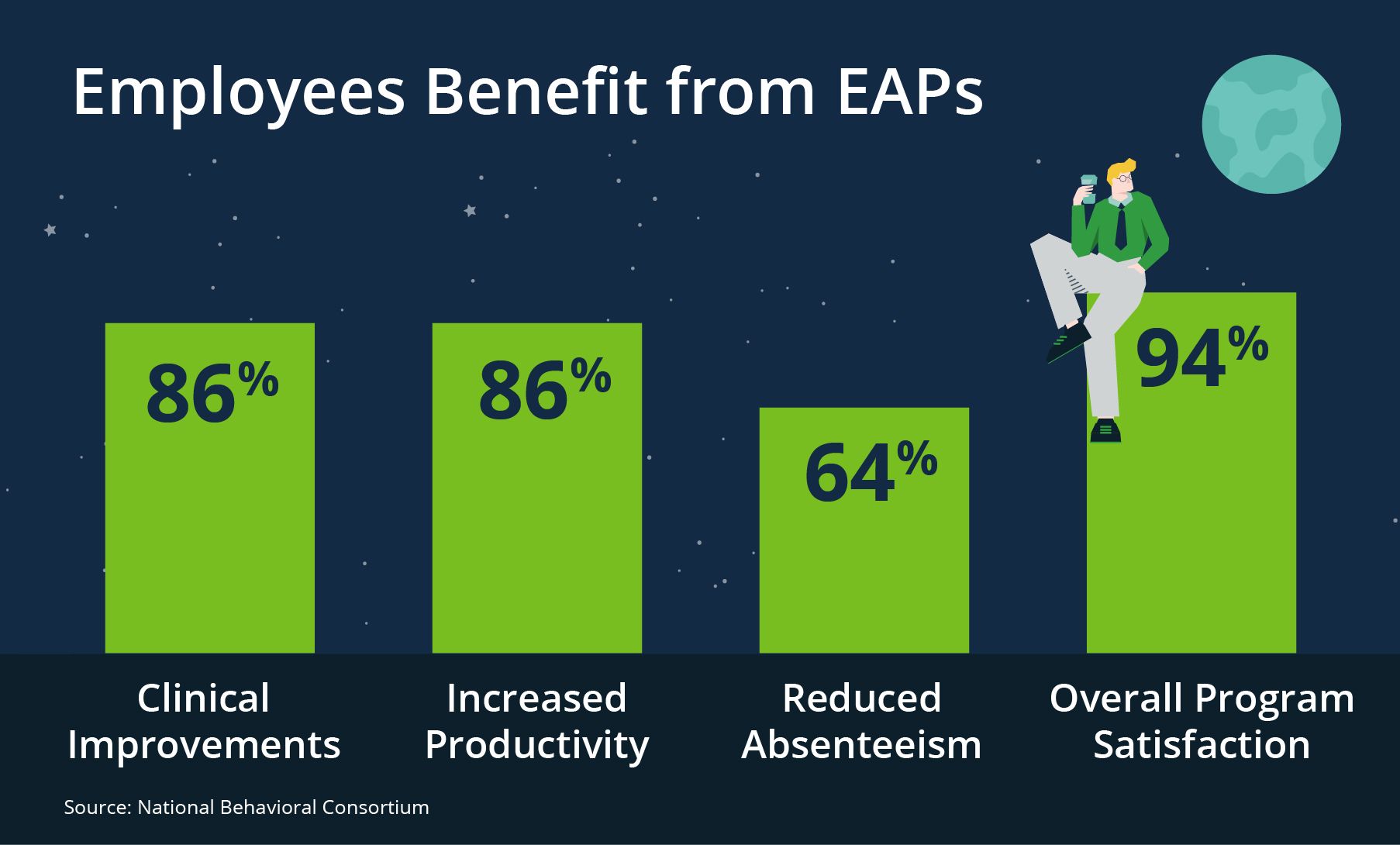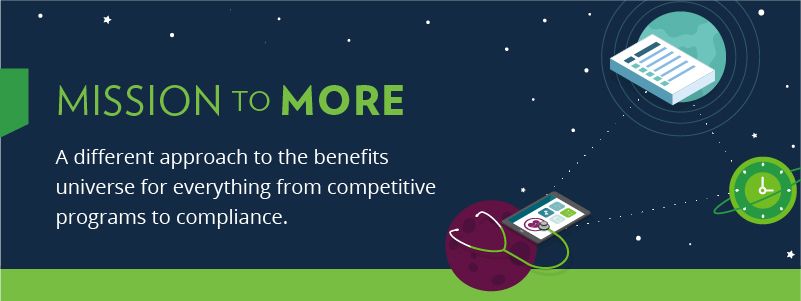Blog
How Your Employee Assistance Program Supports Mental Health
An employee assistance program (EAP) is an effective way to support employees through short-term issues that may distress or distract them from work, improving their overall well-being.
We're just starting to understand the effects of more than two years of lockdowns, closures, and isolation, but one thing is clear—the mental health of various populations has been severely affected. Whether you have a healthcare worker dealing with burnout or an employee facing high anxiety, mental health issues pose a risk to employees that employers cannot ignore.
An employee assistance program (EAP) is an effective way to assist employees through mental health issues and improve their overall well-being. Additionally, mental health benefits can help address workplace mental health stigma, prevent burnout, and promote productivity and motivation.
| At-a-Glance Read time: 7 minutes |
||
|---|---|---|
What are Employee Assistance Programs (EAPs)?
Employee Assistance Programs have evolved to address issues that could have the biggest impact on employee performance. An EAP is typically a separate benefit offered by an employer to help employees navigate short-term issues that may distress or distract them from work. For example, EAP counseling sessions may address issues such as work-related worries, formal mental health or substance use disorders, relationship issues, and other things that could affect well-being and productivity using problem assessment, short-term counseling, and referrals for additional services.
An EAP typically includes some combination of the following resources:
- Short-term counseling: Limited number of sessions with a counselor to help staff members deal with immediate issues. The counselor might also make use of this time to refer employees to additional services, such as substance abuse support groups
- Financial counseling: Resources for employees to handle debt, manage their budgets, etc.
- Legal services: Free or discounted legal representation for bankruptcy, divorce, and other issues or referrals to legal resources
- Adoption assistance: Free legal and financial support through adoption aid or referrals to adoption agencies
- Child and elder care services: Resources and support for caregivers in the areas of child and elder care
- Substance abuse referral services: Short-term counseling and group support services for employees who are struggling with substance abuse
- Workplace trauma counseling: Support for employees experiencing trauma following acts of workplace violence.
- Education and training: Classes, webinars, videos, and other resources covering stress management, mindfulness, resiliency, conflict management, etc.
Typically, an EAP provides a limited number of counseling sessions at no cost to the employees. A sample EAP benefit may offer three to 10 no-cost visits (per year), either in person, virtually, or a combination of both. If the issue is not resolved in the number of counseling visits offered, employees may then transition to behavioral health benefits (explained below). Therefore, it’s a good idea to consider EAP benefits as a first option since it does not require fees or filing claims paperwork.
Behavioral Health Programs versus EAPs: What's the Difference?
Employers can add behavioral health programs as an extra benefit on top of traditional EAP. Alternatively, some behavioral health programs can include EAP as part of their offering.
The main difference between an EAP mental health benefit and a behavioral health program is how they approach addressing issues. An EAP program focuses on external stressors. These include workplace issues, financial difficulties, elder care needs, childcare needs, crisis assistance, or legal issues. EAP counseling sessions are typically offered to employees for a set number of visits at no cost. In comparison, a behavioral health program focuses on the individual and addresses the emotional, mental, and physical sources of stress to promote healthy behaviors.
If an employer offers both, employees can transition from an EAP to behavioral health benefits if they need more assistance. EAP counselors are often also included in the employer’s health plan network of providers. This will allow benefits to continue seamlessly from the EAP to a behavioral health plan for continuity of care.
Below are some differences between behavioral health programs and EAPs:
Utilization Tips for Employers
Choosing an EAP program is just the first step. An ongoing project is to ensure your program is effective and meets the needs of your employees. Below are some ways to boost EAP program utilization:
- Clearly define the scope of EAP services your organization will cover and thoroughly communicate these to managers, employees, and family members
- Be proactive in managing EAP programs to ensure high-quality and relevant services
- Actively coordinate the roles and responsibilities of EAP with other health and productivity programs
- Utilize the EAP’s organizational services to support human resources and disability management functions
- Discuss ways to analyze EAP performance and employee engagement statistics (data confidentially gathered), including validated outcome measurement tools
- Consider conducting periodic intake and/or case assessments to evaluate the quality of the member experience
- Include diversity, equity, and inclusion (DEI) efforts as well as LGBTQ+ and BIPOC-inclusive messaging
- Consider renaming and rebranding the EAP to highlight the EAP as more than a counseling service, but rather one that can support employee and family issues and concerns objectively
- Promote alternative counseling methods, such as telephonic and text, to assist employees and family members with time or transportation constraints

How to Communicate About Your Program
Unfortunately, the stigma around mental health has not fully disappeared, and employees may be hesitant to ask about the help available. Informing employees about EAP programs and what they provide will help with utilization and ensure that employees know about the resource when they need it.
Here are some ways to educate employees about EAPs and mental health coverage:
- Orientation and onboarding: Provide information right when employees start, emphasizing the program's confidentiality and ease of access.
- Company intranet: Keep information and relevant links in an easy-to-find location on the intranet.
- Company newsletter: A periodic reminder in the company newsletter keeps the program top of mind.
- Posters and flyers: These can be placed in common areas such as break rooms to increase the visibility of your program.
- Training and development sessions: Provide training to managers, supervisors, and employees about how to recognize signs of stress or mental health issues in themselves or their colleagues. Remind them that the EAP program includes access to mental health resources.
Adapt to Evolving Employee Needs
Employee needs are evolving, and therefore, the benefits that employers offer must also change. Now more than ever, employees need all the support they can get. Employers should remind their employees of the benefits they have. Promoting the mental wellness programs and informing employees of the number of counseling sessions, different features, and how to access each option will help break down barriers to mental health support, enhance general employee wellness, boost employee morale, and increase productivity.
Our Mission to More series offers guidance from leading specialists on what employees want and how employers can adapt to the new benefits universe. For more guidance on trends and emerging benefits solutions, sign up for Woodruff Sawyer’s Benefits newsletter, which includes all Mission to More articles.
Table of Contents










